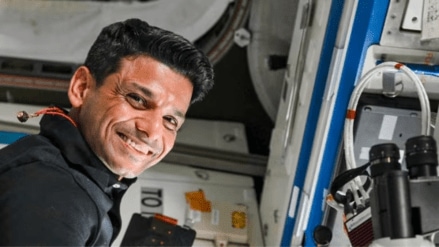Astronaut Shubhanshu Shukla will return to earth on Monday after a historic visit to the International Space Station. The Indian Air Force Group Captain is set to touch down around 3:00 pm after spending more than 18 days in orbit conducting intense science experiments. The Axiom 4 (Ax-4) crew are preparing to undock around 4:30 pm with splashdown off the coast of California.
“As of now, undocking has been scheduled for tomorrow, 14th July at 4:30 PM IST. Arrival back to earth…. splash down scheduled for 15th July at 3:00 PM IST. These timings have a margin window of approximately 1 hour,” Science and Technology Minister Jitendra Singh wrote on X.
According to an update shared by ISRO, Shukla will undergo a week-long rehabilitation programme under the supervision of a flight surgeon after landing in order to re-adapt himself with earth’s gravity. It has been a historic trip for Shukla, who became the first Indian to travel to the ISS and only the second to travel to space after Rakesh Sharma’s pathbreaking spaceflight as part of the then Soviet Russia’s mission to Salyut-7 space station in 1984. The Indian space agency has paid approximately Rs 550 crore for his travel to the ISS — an experience that will help it plan and execute its human spaceflight programme, Gaganyaan, in 2027.
How to watch descent?
The descent will be covered live by NASA — starting with their undocking from a space-facing port of the ISS at around 7:05 am (EDT). The exact time of their departure on board the SpaceX Dragon spacecraft will depend on the weather and other factors. Footage of the departure operations will be streamed live on NASA + from the hatch closing at 4:30 am (EDT).
Shukla and the three other astronauts are expected to board the spacecraft at 2.25 pm IST, wear their space suits and carry out the necessary tests before they begin their journey to the Earth. The ISS is orbiting the planet at a speed of 28,000 km per hour, and the Dragon spacecraft will initiate the autonomous undocking process to gradually slow down and re-enter the planet’s atmosphere for a splashdown off the coast of California.
“The Dragon spacecraft will return with more than 580 pounds of cargo, including NASA hardware and data from over 60 experiments conducted throughout the mission,” NASA said.
Farewell feast 400 kilometers off earth
As the Axiom-4 mission drew to a close, astronauts on board the ISS gathered for a feast with a diverse menu from the six nations they represent.
Currently, there are 11 astronauts on the ISS, seven of Expedition 73 and four of the Axiom-4 commercial mission.
“One of the most unforgettable evenings I’ve experienced on this mission was sharing a meal with new friends, Ax-4, aboard the International @Space_Station,” US astronaut Jonny Kim said in a post on X last week.
“We swapped stories and marvelled at how people from diverse backgrounds and nations came together to represent humanity in space,” he said.
For appetisers, the astronauts made rehydrated shrimp cocktails and crackers and the main course featured savoury chicken and beef fajitas. The cosmonauts capped the night with a delicious cake made from sweet bread, condensed milk, and walnuts, Kim said. Shukla had got aam ras and carrot halwa for the feast, while Polish astronaut Slawosz had brought his native dish, pierogi with cabbage and mushrooms, to the ISS.
Historic’ trip
Shukla has spent 18 days in space, witnessing 16 sunrises and sunsets every day as the ISS travels at a speed of 28,000 km per hour in an orbit about 400 km above the Earth. He worked on the microalgae experiment during is stay, deploying and stowing samples that could one day provide food, oxygen and biofuels for deep-space missions. A statement by Axiom Space explained that the resilience of microalgae made it a promising asset to sustain life beyond Earth.
“Exercise research and spacesuit maintenance topped the schedule for the Expedition 73 and Axiom Mission 4 (Ax-4) crews on Thursday,” a NASA statement added.
The crew also continued the Voyager Displays study, which examines how spaceflight affects eye movement and coordination.
The crew collected data for a study to explore how astronauts perceive and interact with their environment in orbit, which is critical for designing mentally supportive habitats for long-duration missions.
Another study focused on cerebral blood flow, investigating how microgravity and elevated carbon dioxide levels affect cardiovascular function, which could later benefit both astronauts and patients on Earth.
Radiation exposure was monitored using the compact Rad Nano Dosimeter, a tool to assess astronaut safety.
The crew participated in the Acquired Equivalence Test, a cognitive experiment that measures learning and adaptability in space and supported the PhotonGrav study by collecting brain activity data to explore neuroadaptive technologies for space and medical applications.
